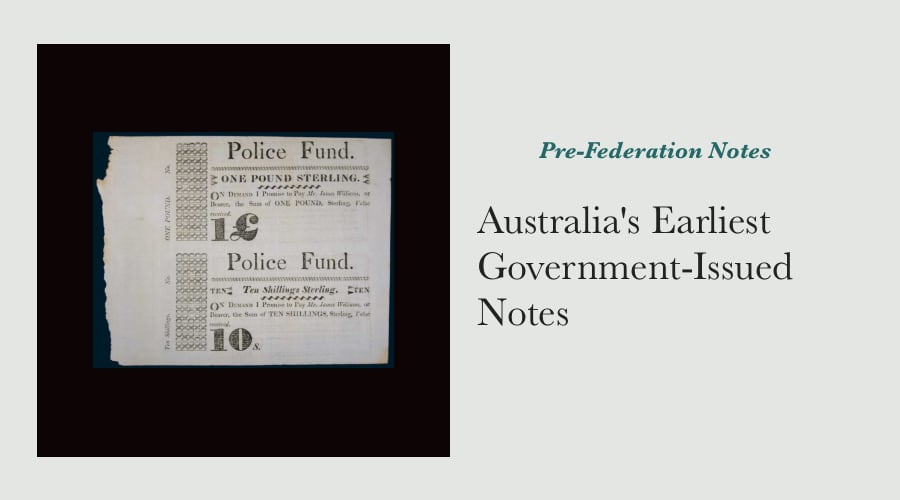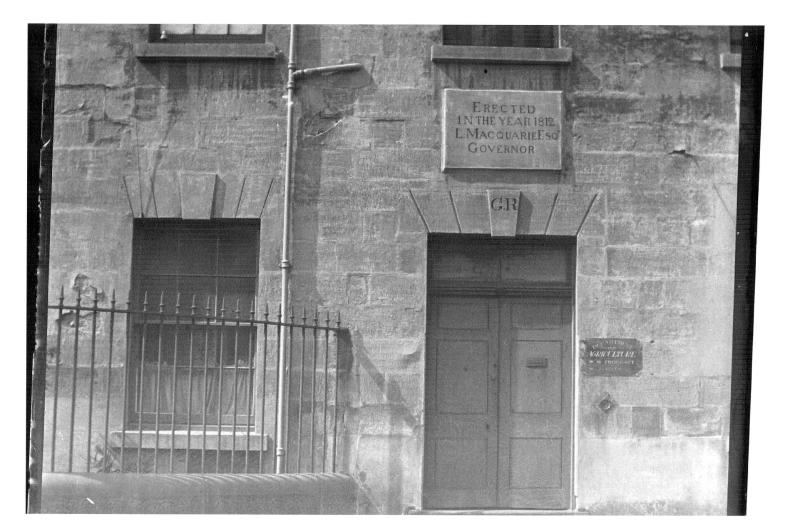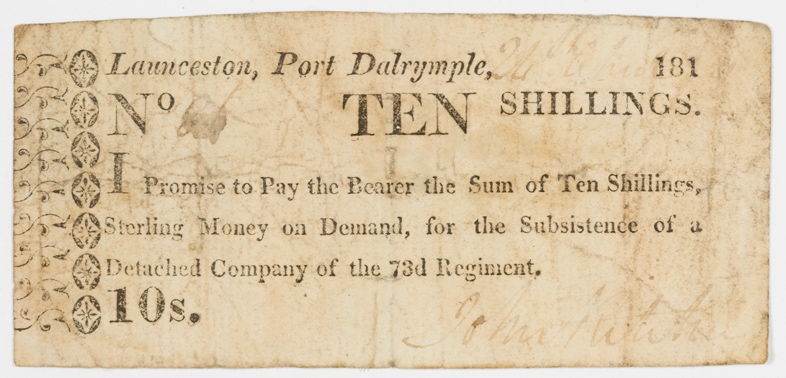Australia's Earliest Government-Issued Notes

Australia’s Earliest Government-Issued Notes
Over the years I’ve seen several of the notes issued by the NSW Colonial Police Fund - judging by the prices they realised at auction, I could see they were rare and highly prized, but I never really appreciated their importance until recently.
These notes are so early in Australia’s settled history that very little has been written about them. They fall outside the scope of our standard guides to Australian coins and notes, yet they were essential to the foundation of our national economy. They are so important, they should be understood and acknowledged for what they are - the first official banknotes to be used on our continent.
The question I had about the NSW Colonial Police Fund notes was - are these the earliest known notes issued by a government body on Australia’s shores? If they weren’t, what was?
Authors such as Bill Mira have conducted detailed research into certain aspects of these notes, but it's fair to say that information hasn't been seen beyond a select group of enthusiasts. This means the question was a lot harder to answer than I expected it to be - there were many different types of notes (both public and private) issued in NSW and Van Diemen’s Land before 1825, and there were a number of different colonial authorities that issued notes.
As if that wasn’t already hard enough to decipher, it is also important for us numismatists to determine whether any of these notes actually still exist. After all, even if some notes were printed and issued, if they no longer exist or simply aren’t available for collectors to buy, should we even consider them as being part of a “set” of colonial paper currency?
If 1788 is our start date for this investigation, I’ve chosen 1835 as the end date - that was a decade after sterling coinage was adopted comprehensively and roughly when the volume of the colony’s exports equalled imports, and there was enough sterling for the populace to use instead of privately issued currency notes.1
My task then was to work out:
- Which government authorities issued notes in Australia before 1835?
- What types of notes were issued by government authorities in Australia before 1835?
- Which of those notes still exist?
- Which of those notes are available for collectors to buy?
The article that follows below is based upon all the information that’s been available to me as of June 2023. It will be updated with any new information that comes to light because of this publication.
Which Government Authorities Issued Notes in Australia Before 1835?
The first representatives of the British government on Australian soil were the military regiment that oversaw the convicts - the New South Wales Marine Corps. They rotated out after their deployment ended, and were replaced by a series of different regiments, each with the same responsibility:
| Military Regiments in NSW (1788 ~ 1835) |
| The New South Wales Marine Corps (1788 ~ 1792)2 |
| The NSW Corps (1792 ~ 1810) |
| The 73rd Regiment (1809 ~ 1814)3 |
| The 46th Regiment (1814 ~ 1817) |
| The 48th Regiment (1817 ~ 1824) |
| The 3rd Regiment (1823 ~ 1827) |
| The 40th Regiment (1824 ~ 1829) |
| The 57th Regiment (1825 ~ 1832) |
| The 39th Regiment (1827 ~ 1832) |
| The 63rd Regiment (1829 ~ 1833) |
Before we relax and accept that as the (lengthy) definitive list of government bodies that may have issued their own paper money, we need to remember that each military regiment was comprised of several smaller operational units. Our economic history shows that several of these units had officers with the authority to issue notes.
The NSW Commissariat - The Sole Buyer of Produce
A commissary is typically a facility used to provide food, supplies, and other goods to a specific group of people such as military personnel. Commissaries often operate in locations where regular stores are not readily available.
A Commissariat is a department or organisation responsible for providing and managing supplies, logistics, and other provisions to a specific group of people, such as a military force, a fleet of ships, or an expedition.
The officer in charge of the Commissariat in colonial NSW was (at various times) the Commissary-General, the Acting Commissary-General or the Assistant Commissary-General.
In the early years, the Commissariat was the only buyer available for the produce of the colony. Due to an initial lack of ready cash in the colony and the high credit rating of the Commissariat, its store receipts and notes were used as currency for many years.

NSW Commissariat Store - Now Demolished
Image Source: University of Sydney Union
NSW Commissariat Store Receipts
The store receipts issued by the Commissariat in colonial NSW appear to be the very first form of government-issued paper currency issued on Australian soil.
Store receipts were issued for produce delivered to the government stores for resale and were in the form of an order on the Commissary General, to pay a named person named or the bearer a specific sum, for a particular commodity.4
Whereas the Paymaster’s Bills issued by the Commissariat were signed either by the Commissary-General, the Acting Commissary-General or the Assistant Commissary-General, the store receipts were signed by “…the very storekeepers…”5 that took delivery of the goods being sold. Store receipts were payable not by the storekeeper, but by the NSW Commissary-General.
The earliest known mention of the store notes being in use was in 1795: Mrs. Elizabeth MacArthur wrote that in payment of the grain raised by the settlers "The Commissary issue a receipt approved by the Governor, and these receipts pass current here as coin, and are taken by master of ships and other adventurers who come to these parts with merchandise for sale."6
NSW Commissariat Notes
The notes issued by the NSW Commissariat differ from the store receipts, in that they were endorsed or signed by the Commissary-General. Just as with the store receipts, the store notes were issued for produce that was delivered to the government stores for resale. They were in the form of an order on the Commissary General, to pay a person named (or the bearer) a specific sum, for a particular commodity.7

Paymaster's Bill issued by 73rd Regiment, 1813
Image Source: Dixson Library, State Library of New South Wales
Paymaster’s Bills
The Paymaster of each regiment had the authority to issue what were effectively promissory notes in exchange for produce and other goods for the “…sustenance of the regiment…”8 One economics author states paymaster’s notes “…were issued as salary payments to military officers.”9
Paymaster’s Bills differ from Store Receipts in that they were not issued for produce or goods delivered to the government stores (the Commissariat) that were to be resold. Payment was made in the form of a bill, payable in Sterling upon demand.
NSW Colonial Police Fund Notes
In March 1810, Governor Lachlan Macquarie increased the duty on all imported spirits by one shilling per gallon. The duty was paid into what Macquarie named “The Colonial Police Fund”, which began on April 1st 1810.10 Surgeon D'Arcy Wentworth was appointed as the first Treasurer of the fund.
The Colonial Police Fund was effectively the consolidated revenue fund of the Colony, which made meant Wentworth was effectively the Treasurer of the Colony. The Fund was used to pay for public works to the benefit of all colonists, including: “… the Expense of the Jail and Police Establishments, the Erection of Wharves, Quays and Bridges, and the making and repairing of Streets and Roads within the Limits of the Town of Sydney.”11
Notes prepared for the Police Fund “were issued to persons who had claims on the Fund.”12 Records held by the State Records of NSW list several payments made by the Police Fund13, typically to contractors for repairs of government facilities.
In his paper on the paper money of colonial Australia, Percy Marks states that “These notes passed freely current…”14
Mira also states that “…the pieces were a circulating media.”15
The Colonial Police Fund was dissolved in 1824.16
Known Examples of Publicly Issued Colonial Currency Notes
Publicly Issued Currency Notes from Australia’s colonial era are far rarer than the equivalent notes issued by private individuals. This is due to their enduring monetary value - whereas the financial viability of many of the issuers of private currency notes was uncertain and many currency notes lost their value as a result, publicly issued notes had much better backing and were far more reliable, so maintained their value over time.
Worthless scraps of paper that no longer have a redemption value are more likely to be set aside as collectibles than highly valuable media of exchange.
NSW Store Receipts: The earliest dated “store receipt” from the NSW Commissariat that has been recorded as still being in existence is dated 1802. In his paper titled "Australian “Paper Currencies”, Percy Marks stated that, as of 1919, it was held by the “London Record Office.”17 This information is being verified at present.
NSW Commissariat Notes: None of these notes are known to still be in existence, much less remain available to collectors. I am yet to see a record of any being held by a public collection in NSW, or elsewhere in Australia. A very small number of bills of exchange issued by the New South Wales Commissariat are known in private hands, these are different to the notes issued by the Commissariat, however. Notes issued by the Commissariat in Van Diemen’s Land as well as the Swan River Colony are known in private hands, they are dated slightly later than the period discussed here.
Paymaster’s Bills: These are not explicitly listed as being held in any public collection that I have seen so far. That said, the Dixson Collection in the State Library of New South Wales does hold several paymaster’s notes, issued by the 73rd Regiment in Launceston in 1813. One of those paymaster’s notes is dated April 24th, 1813, which is either the earliest date seen on a publicly-issued note still in existence, or is incredibly close to it.
Police Fund Notes: A very small number of these notes in different forms (single and uncut) are held in the State Library of New South Wales; in the National Library of Australia as well as in private hands. There are 7 different note forms of the Type II Police Fund notes known to be held by collectors, each are unissued:
|
Denomination |
Number Known |
|
Uncut Vertical Pair of £1 and 10/- |
3 |
|
Single £1 |
1 |
|
Single 10/- |
1 |
|
Uncut Vertical Pair of 5/- and 2/6 |
1 |
|
Single 5/- |
1 |
As the earliest-known paper notes issued by a government authority on Australian soil, the Police Fund notes occupy a unique position in our national economic history. They are a rare and exclusive artefact of the foundation of Australia’s economy.
Footnotes:
1 Holder; RF, "Bank of New South Wales - A History", Angus and Robertson, Sydney, 1970, p p5.
2 https://en.wikipedia.org/wiki/New_South_Wales_Marine_Corps
3 https://www.mq.edu.au/macquarie-
archive/journeys/related/73rd.html
4 Marks; Percy, "Australian “Paper Currencies, Self-published, Sydney, 1919, p 8.
5 Marks; Percy, "Australian “Paper Currencies, Self-published, Sydney, 1919, p 10.
6 Historical Records of New South Wales Vol 2 page 511.
7 Marks; Percy, "Australian “Paper Currencies, Self-published, Sydney, 1919, p 8.
8 Marks; Percy, "Australian Paper Currencies, Self-published, Sydney, 1919, p 11.
9 Becker; Frank, "Bills, notes and money in early New South Wales" in the Financial History Review, Vol 18.1, 2011, p 74.
10 Swanton; Bruce, "THE POLICE OF SYDNEY 1788-1862", AustraLian Institute Of CriminoLogy, Sydney, 1984, p26.
11 Historical Records of Australia, Series I, Vol. VII, p.254.
12 Mira; WJ, "The Note Issue of the Colonial Police Fund of New South Wales 1810 - 1824", Metropolitan Coin Club of Sydney, Sydney, 1979, p 11.
13 https://colsec.records.nsw.gov.au/c/F13c_coo-coz-16.htm
14 Marks; Percy, "Australian “Paper Currencies, Self-published, Sydney, 1919, p 11.
15 Mira; WJ, "The Note Issue of the Colonial Police Fund of New South Wales 1810 - 1824", Metropolitan Coin Club of Sydney, Sydney, 1979, p 13.
16 Swanton; Bruce, "THE POLICE OF SYDNEY 1788-1862", AustraLian Institute Of CriminoLogy, Sydney, 1984, p45.
17 Marks; Percy, "Australian “Paper Currencies, Self-published, Sydney, 1919, p 11.